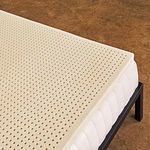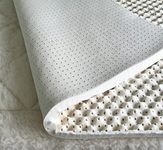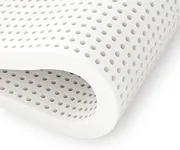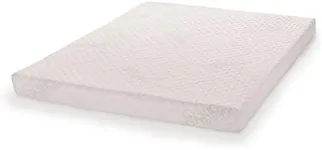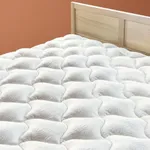Buying Guide for the Best Latex Mattress Toppers
Choosing the right latex mattress topper can significantly enhance your sleep quality by providing additional comfort and support. When selecting a latex mattress topper, it's important to consider several key specifications to ensure you find the best fit for your needs. Understanding these specifications will help you make an informed decision and enjoy a restful night's sleep.Material TypeLatex mattress toppers can be made from natural latex, synthetic latex, or a blend of both. Natural latex is derived from rubber tree sap and is known for its durability, breathability, and eco-friendliness. Synthetic latex is made from petrochemicals and tends to be less expensive but may not offer the same level of comfort and longevity. A blend combines both types to balance cost and performance. If you prioritize sustainability and long-lasting comfort, natural latex is the best choice. If budget and moderate performance are more important, synthetic or blended latex may be suitable.
Firmness LevelThe firmness of a latex mattress topper can range from soft to extra firm. This specification is crucial because it affects how the topper feels and supports your body. Soft toppers provide a plush, cushioning feel and are ideal for side sleepers or those who prefer a softer surface. Medium firmness offers a balance of comfort and support, suitable for back sleepers or those who need moderate support. Firm toppers provide strong support and are best for stomach sleepers or individuals with back pain. Choose the firmness level based on your sleeping position and personal comfort preference.
ThicknessLatex mattress toppers come in various thicknesses, typically ranging from 1 to 4 inches. The thickness determines the level of cushioning and support the topper provides. A 1-2 inch topper adds a slight layer of comfort and is suitable for minor adjustments to your mattress. A 3-inch topper offers more substantial support and is ideal for improving an older mattress or adding significant comfort. A 4-inch topper provides maximum cushioning and support, perfect for those who need extra pressure relief or have a very firm mattress. Consider your current mattress condition and the level of comfort you desire when choosing the thickness.
DensityDensity refers to the weight of the latex per cubic foot and affects the topper's durability and support. Higher density latex toppers (4-5 pounds per cubic foot) are more durable and provide better support, making them ideal for heavier individuals or those seeking long-term use. Lower density toppers (3-4 pounds per cubic foot) are lighter and may offer a softer feel but might not last as long. If you need a durable topper that maintains its shape and support over time, opt for a higher density. For a softer, more temporary solution, a lower density may suffice.
BreathabilityBreathability is an important factor, especially if you tend to sleep hot. Latex is naturally breathable due to its open-cell structure, which allows air to circulate and helps regulate temperature. Some toppers also feature additional ventilation holes to enhance airflow. If you are a hot sleeper, look for a topper with good breathability to ensure a cooler and more comfortable sleep environment. If temperature regulation is not a major concern for you, standard latex toppers without extra ventilation may be adequate.
Allergen ResistanceLatex is naturally resistant to dust mites, mold, and other common allergens, making it a great choice for allergy sufferers. However, some people may have a latex allergy, so it's important to ensure the topper is hypoallergenic and free from any potential irritants. If you have allergies or sensitivities, opt for a natural latex topper that is certified hypoallergenic. If you are not prone to allergies, this specification may be less critical, but it's still a good idea to choose a topper with inherent resistance to allergens for a healthier sleep environment.

